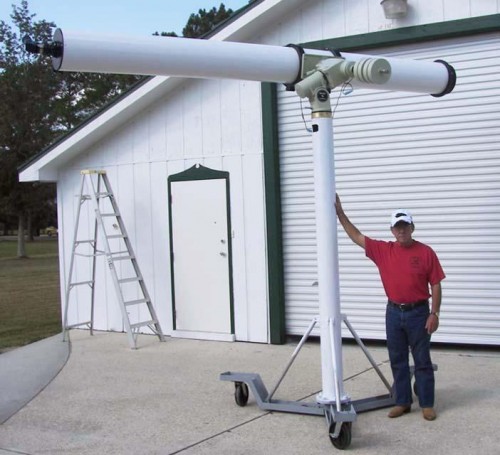November 27
November 27, 2007November 29
November 29, 2007Dr. Holly Gilbert, a solar physicist at Houston’s Rice University, came to Schriever recently to attend the dedication of a new solar telescope named in her honor at the St. George Observatory, a private facility owned by amateur astronomer Ken Stage.
“It’s wonderful to have this telescope,” Gilbert said. “I was very surprised. He does a good job. It takes a lot to run something like this.”
“I haven’t been around a lot of amateur telescopes,” she said, “but this one looks longer. This is amazing compared to the other telescopes.”
Except for a brief visit before Hurricane Katrina, the telescope dedication marked the first time in Louisiana for Gilbert, who also plays the cello and is an expert at shooting pool.
She came to Stage’s attention after he saw her being interviewed recently on “The Universe,” a special History Channel series about astronomy.
“She impressed me,” said Stage, who owns a tugboat company. “She can take the complex and make it understandable. I contacted her to come to the cane fields of south Louisiana.”
Gilbert agreed. She and her mother stayed the weekend at Madewood Plantation in Napoleonville, before Gilbert had to return to Houston to teach Monday classes.
Stage’s observatory contains a total of five telescopes and is located on two-and-a-half acres of land in the backyard of his house on St. George Road. He does not advertise his facility, but relies on word of mouth.
The telescopes are open for viewing on Fridays and Saturdays, sunset to midnight, by appointment only. Admission is $9. Students and seniors pay $8.
Besides Gilbert’s, the observatory has telescopes named for Apollo 16 astronaut Charles Duke and astrobiology researcher Cheryl Nickerson.
Both Duke and Nickerson came to Schriever for their telescope dedications, and to deliver lectures. Other notables who have visited Stage’s observatory to give talks are SR-71 Blackbird developer Rick Graham, and Col. Joe Kittinger, who parachuted off a balloon 19-and-a-half miles above the earth near the edge of space in 1960.
The lecture room at Stage’s observatory also contains a Van de Graaff generator, liquid nitrogen containers, a saturated cloud chamber showing cosmic ray particles, and a 183-pound meteorite discovered in Argentina in 1579.
In addition, the room has a display of (earth) rocks, models of Saturn rockets and posters with views of the universe, including one showing a band of the Milky Way galaxy taken from the observatory.
Prior to Gilbert’s lecture, Stage conducted a demonstration in which he pneumatically blasted a bath towel through a wooden board using a “cannon” made of PVC called the MegaLauncher. Gilbert was given the honor of pressing the button setting off the contraption.
Stage frequently gives a demonstration for visiting students in which he plunges a penny in very cold liquid nitrogen. He then allows a student to strike the coin, shattering the hard metal.
The observatory also hosts Scout and school groups, and conducts a summer camp for kids. Stage allows the Scouts to camp overnight “to get a feel of the universe,” he said.
Teaching people about astronomy takes Stage back to when he saw a meteor’s flash make the night sky glow, sparking his fascination with space.
While a quartermaster in the U.S. Coast Guard during the 1960s, Stage learned celestial navigation. Looking through his sextant, he saw that different stars were colored red, white or blue, depending on temperature variance.
Since then, astronomy has “been my burning passion,” he said.
Stage links that passion for astronomy with theological concepts (two other scopes at the observatory are named after books of the Bible).
“There’s a brass plaque by the telescopes that says, ‘Light is the shadow of God,'” he said. “We strictly teach science. But we’ve had church groups wanting to know about religion versus science. We’re all people of faith. I sit back, look at how it fits together.”
“I was (once) a guest speaker at UNO,” said Stage, who does not have a degree in astronomy.
While at UNO, “one man poked fun at me,” he said. “I asked, Who believes in the big bang? They were unanimous.”
Stage pointed out to the man that the big bang theory was originated by the Belgian Roman Catholic priest Georges Lemaitre.
Amateur astronomer Ken Stage, of Schriever, recently added a solar telescope at his St. George Observatory. * Photo by MIKE BROSSETTE









